Loading
Archives of Medical Case Reports
ISSN: 2691-7971
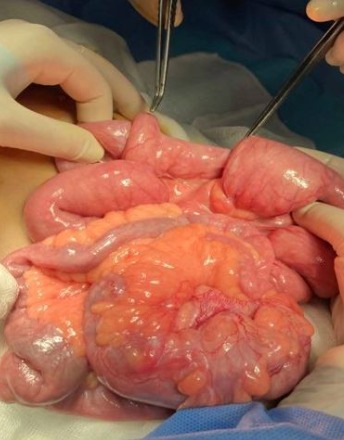
2023
Volume 5, Issue 1, p1-43
Articles published in this issue are Open Access and licensed under Creative Commons Attribution License (CC BY NC) where the readers can reuse, download, distribute the article in whole or part by mentioning proper credits to the authors.
Transient Right Bundle Branch Block with S1Q3T3 Pattern in Pulmonary Embolism
Riddhi Chauhan, Fadi Yacoub, Parima Saxena, Mary Mallappallil, Sabu John
A 69-year-old woman with hypertension, hyperlipidemia, sleep apnea, gastroesophageal reflux disease, and recent knee replacement was brought to the emergency room (ER) for syncope. She had her physiotherapy session earlier in the day and became symptomatic with dizziness, shortness of breath and had loss of consciousness.
Arch Med Case Rep, 2023, Volume 5, Issue 1, p1-4 | DOI: 10.33696/casereports.4.019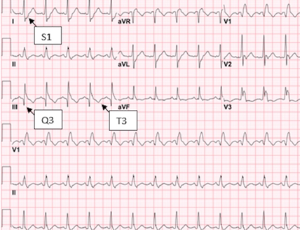
Bannayan Zonana Syndrome: An Unusual Cause of Intussusception and Protein Losing Enteropathy in a Child
Maaloul Ines, Ben Dhaou Mahdi, Cheikhrouhou Taycir, Zghal Mohamed, Aloulou Hajer, Mhiri Riadh, Ben Ameur Salma, Kamoun Thouraya
Bannayan-Zonana syndrome (BRRS) is a rare genetic disorder characterized by macrocephaly, numerous soft tissue and visceral hamartomas, and lipomas. Because of the risk of fatal bleeding and visceral neoplasia in adulthood, recognizing this disease is critical.
Arch Med Case Rep, 2023, Volume 5, Issue 1, p5-9 | DOI: 10.33696/casereports.4.020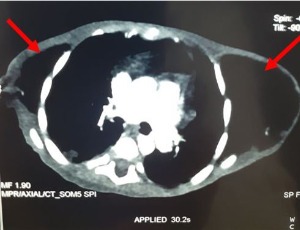
Case Report on Ogilvie Syndrome in a Non-Surgical Candidate
Yvonne Walker, James P. Chiou, Rishbha Dua, Miguel Diaz-Miret
Ogilvie syndrome, also known as “paralytic ileus of the colon,” is characterized by pseudo- obstruction of the colon without any component of mechanical obstruction; and presents as a massively distended abdomen. If left untreated, it carries a high risk of colonic perforation and ischemia leading to death.
Arch Med Case Rep, 2023, Volume 5, Issue 1, p10-14 | DOI: 10.33696/casereports.4.021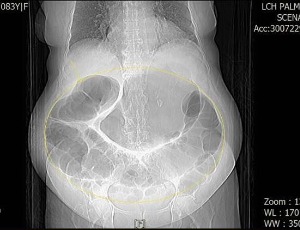
Endovascular Management of Vascular Closure Device (VCD) Thrombotic Complications
Bola F. Habeb, George M. Yousef
Percutaneous coronary angiography and interventions have become essential diagnostic and therapeutic tools in coronary artery disease management. Vascular closure devices were introduced in the early 1990s. They provided a safe, reliable, and efficient method to achieve puncture site hemostasis. Collagen-based vascular closure devices are frequently used modalities.
Arch Med Case Rep, 2023, Volume 5, Issue 1, p15-17 | DOI: 10.33696/casereports.4.022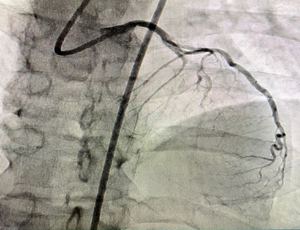
Small Cell Carcinoma of the Cervix: A Case Report and Literature Review
Xi Chen, Keita Mamady, Zilin Li, Zhaohui Fang, Traore Bangaly, Hong Liu
Cervical small cell carcinoma (SCC) is a rare disease, with a high degree of malignancy and a poor prognosis. Para-aortic lymph nodes (PALN) are frequent sites of recurrence after pelvic chemoradiotherapy. In the present study, we report the case of a 26-year-old female patient with cervical SCC who suffered for two times PALN relapses.
Arch Med Case Rep, 2023, Volume 5, Issue 1, p18-23 | DOI: 10.33696/casereports.4.023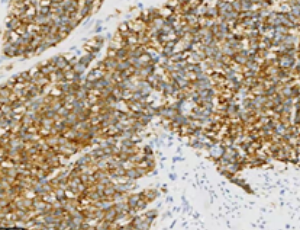
Two Cases of Burkitt Lymphoma Presenting as Solid Ovarian Masses
Blessing N. Ngam, James A. Brown, Lorraine Elit, Richard L Bardin, Mark J. Snell
Endemic Burkitt lymphoma has been associated with the Epstein Barr Virus (EBV), particularly in malaria-endemic regions. Primary ovarian Burkitt is an infrequent entity of this disease, and its diagnosis still poses a challenge.
Arch Med Case Rep, 2023, Volume 5, Issue 1, p24-29 | DOI: 10.33696/casereports.4.024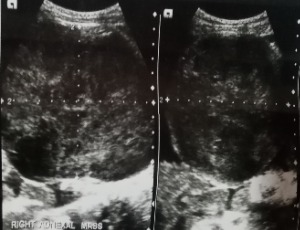
Primary Spinal Cord Haemorrhage during COVID-19 Illness: A Novel Addition to the Endless Spectrum of Neurological Manifestations?
Mehul Desai, Sunila Jaggi, Nirmal Surya
Since its discovery in December 2019 severe acute respiratory syndrome coronavirus-2 (SARS-COV2), coronavirus disease-19 (COVID-19) pandemic has opened up a pandora’s box and put the entire health-care industry globally under trial by fire. Neurological manifestations of it started becoming apparent in first few months and as of now we are still facing never-ending gamut of central nervous system (CNS) disorders related to SARS-COV-2 infection.
Arch Med Case Rep, 2023, Volume 5, Issue 1, p30-33 | DOI: 10.33696/casereports.4.025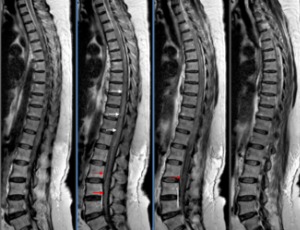
Case Report of Pulmonary Embolism with Right Ventricular Strain in a Young Female
Yvonne Walker, James P. Chiou, Miguel Diaz-Miret
Acute pulmonary embolism (PE) is when one or more thrombus travel to the lungs and obstruct the pulmonary artery or one of the branches of the pulmonary tree, producing signs and symptoms immediately after the obstruction. Saddle pulmonary embolism (SPE) is a rare type of acute PE that can lead to hemodynamic instability and death. The incidence of pulmonary embolism increases with age. In women, the risk of PE increases with pregnancy, hormonal contraceptives, and hormone replacement therapy.
Arch Med Case Rep, 2023, Volume 5, Issue 1, p34-37 | DOI: 10.33696/casereports.4.026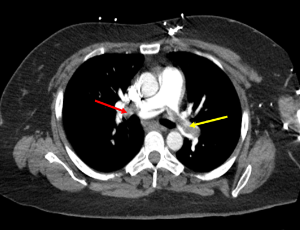
Resolution of Osborn Waves after the Complete Resolution of Spontaneous Pneumothorax in a Normothermic Patient
Arafat Ali Farooqui, Syed Mohammad Mazhar Uddin, Sanjay Kumar Maheshwari, Omair Ali Khan, Azka Naeem, Samra Hameed, Shelly Brejt, Susan Lin
We report a case of Osborn waves occurring in a 55-year-old normothermic male patient with spontaneous pneumothorax that resolved with the resolution of the pneumothorax. The patient was presented with a 2 week history of shortness of breath, pleuritic chest pain, and cough. He was found to have a left sided pneumothorax that persisted even after chest tube placement.
Arch Med Case Rep, 2023, Volume 5, Issue 1, p38-40 | DOI: 10.33696/casereports.5.027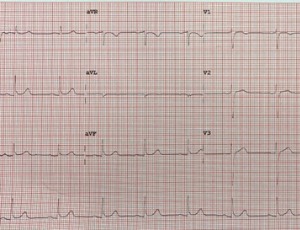
Colchicine Intoxication Subsequent to an Autolytic Attempt with Positive Evolution
Beatriz Nieto Martino, Walter Andrés Ramírez Lajones, Ángela Alonso Ovies
Background and objectives: Colchicine is a drug that has been used to treat gout for several centuries, it is also indicated in certain autoimmune diseases and has been tested as a chemotherapeutic. Only a few cases of intoxication by this drug have been described, but it is known that it has a narrow therapeutic margin (0.5 to 0.8 mg/kg), almost always resulting in fatal results above these limits.
Arch Med Case Rep, 2023, Volume 5, Issue 1, p41-43 | DOI: 10.33696/casereports.5.028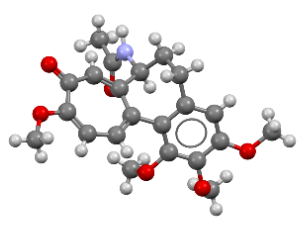
Recommended Articles
Gender Disparities in Outcomes Following Pulmonary Embolism Treatment in the Intensive Care Unit; A Multi-center Retrospective Cohort Study
Pulmonary embolism (PE) is a blockage of blood flow in the pulmonary artery bed that can result in a life-threatening and potentially reversible right ventricular failure [1]. PE remains one of the leading causes of poor prognosis and death, particularly when a shock or right ventricular failure occurs [2]. According to studies, PE is generally manifested in a nonspecific manner
Machine Learning for Healthcare: Emerging Challenges and Opportunities in Disease Diagnosis
Diagnosis is a process that identifies, explains, or establishes the individual’s disease from its symptoms and signs. Early and precise diagnosis is crucial since it influences the efficacy of treatment and avoids longterm complications for the infected person. Further, in the case of infectious diseases, undiagnosed patients can transmit the disease to a healthy population unknowingly. Besides, most of the diseases evolve with the time that significantly affects the clinical outcomes.
Energy Expenditure and Nutrition in Neurogenic Obesity following Spinal Cord Injury
Worldwide, obesity is a public health concern and a metabolic ailment characterized by excessive adipose tissue accumulation resulting from an imbalance of energy expenditure and energy intake [1]. This disorder is a known risk factor for cardiovascular disease, type 2 diabetes mellitus, dyslipidemia, hypertension, and metabolic
Long-Term Use of Oral Bisphosphonates and Fracture Risk in Men with Traumatic Spinal Cord Injury
Lower extremity fractures in individuals with a spinal cord injury (SCI) cause significant morbidity [1] and contribute to excess mortality [2]. Early identification of persons at highest risk for fracture is possible using bone mineral density (BMD) testing by dual-energy X-ray absorptiometry (DXA) imaging
Cortical Visual Impairment (CVI): An Atypical Manifestation of Osmotic Demyelination Syndrome in a Child
Osmotic Demyelination Syndrome (ODS) is a unique process of selective demyelination and destruction of oligodendrocytes and astrocytes in specific areas of the brain that usually occurs a few days after an osmotic stress [1]. ODS has been described most frequently in association with a rapid correction of hyponatremia, though it may occur with other electrolyte or metabolic abnormalities.
Commentary on: Echocardiography in Pulmonary Arterial Hypertension: Is It Time to Reconsider Its Prognostic Utility?
Pulmonary Arterial Hypertension (PAH) represents a rare but devastating disease due to small pulmonary arterial vessels remodelling and increased pulmonary vascular resistance leading to right ventricular dysfunction, right heart failure and death.
CD146-Positive Tumors are Associated with Venous Thromboembolism
CD146, also known as melanoma cell adhesion molecule (Mel-CAM), MUC18, S-Endo1, A32 antigen, metastasis cell adhesion molecule (MET-CAM), and hemopoietic cell adhesion molecule (HEMCAM), is an integral membrane glycoprotein belonging to the immunoglobulin superfamily. It is constituted of two variable regions (V) and three
A Rodent Lumbosacral Spinal Cord Injury Model Reflecting Neurological and Urological Deficits of Humans
Spinal cord injury (SCI) to the terminal segments of the spinal cord causes severe disruption of the neural circuitry of the bladder, resulting in neurogenic underactive bladder (nUAB). We developed a rodent lumbosacral injury model to investigate the effects of bladder function and structure.
Colchicine in COVID-19 —The Colcorona Trial
Colcorona was a multicenter, international study promoted by the Montreal Heart Institute, Canada, whose main objective was to test the effects of colchicine in non-hospitalized patients with COVID-19. So far, the majority of studies addressed hospitalized patients which is understandable since mortality occurs mainly among those individuals.
B-cell Acute Lymphoblastic Leukemia with a Normal Platelet Count, Presenting as a Limp in a 2-year-old Child
Limping in children is a common complaint made at pediatric, pediatric orthopedic and in emergency departments. It is defined as a deviation from the normal gait pattern expected for the child’s age. Especially in young children, the ambiguities in the signs and symptoms necessitate extensive investigations to enable a reliable medical assessment for the etiological dilemma of limping.
Multiple Myeloma with Neutrophilia: Two Etiologic Pathways for a Rare Presentation of a Common Diagnosis
Multiple myeloma (MM) is a common hematologic malignancy, with 32,110 new cases diagnosed in the United States in 2019, resulting in 12,960 deaths. While neutrophilia
is also a common entity, it most often arises secondary to other etiologies, such as infection or inflammatory processes.
Transient Right Bundle Branch Block with S1Q3T3 Pattern in Pulmonary Embolism
A 69-year-old woman with hypertension, hyperlipidemia, sleep apnea, gastroesophageal reflux disease, and recent knee replacement was brought to the emergency room (ER) for syncope. She had her physiotherapy session earlier in the day and became symptomatic with dizziness, shortness of breath and had loss of consciousness.
Bannayan Zonana Syndrome: An Unusual Cause of Intussusception and Protein Losing Enteropathy in a Child
Bannayan-Zonana syndrome (BRRS) is a rare genetic disorder characterized by macrocephaly, numerous soft tissue and visceral hamartomas, and lipomas. Because of the risk of fatal bleeding and visceral neoplasia in adulthood, recognizing this disease is critical.
Case Report on Ogilvie Syndrome in a Non-Surgical Candidate
Ogilvie syndrome, also known as “paralytic ileus of the colon,” is characterized by pseudo- obstruction of the colon without any component of mechanical obstruction; and presents as a massively distended abdomen. If left untreated, it carries a high risk of colonic perforation and ischemia leading to death.
Endovascular Management of Vascular Closure Device (VCD) Thrombotic Complications
Percutaneous coronary angiography and interventions have become essential diagnostic and therapeutic tools in coronary artery disease management. Vascular closure devices were introduced in the early 1990s. They provided a safe, reliable, and efficient method to achieve puncture site hemostasis. Collagen-based vascular closure devices are frequently used modalities.
Current Spinal Cord Injury Animal Models are Too Simplistic for Clinical Translation
Spinal cord injury (SCI) is a devastating disease that has a global impact on individuals and society. The number of SCI cases in 2016 was 27 million worldwide, which was predominantly due to falls and road traffic collisions. Alarmingly, the number of new SCI cases in most countries has risen over the last few decades.
Generation of Human Oligodendrocyte Progenitors for Treatment of Demyelinating Diseases and Spinal Cord Injury
Glial cells play a critical role in the development and function of the mammalian central nervous system (CNS). Among other roles, these cells provide the myelin sheath needed for the efficient propagation of impulses along nerve fibers, provide trophic support for neuronal cells, and remove toxins and excess neurotransmitters from the interstitial space. Transplantation of glial cells or glial progenitors into the diseased or injured CNS can provide therapeutic benefits.
Two Cases of Burkitt Lymphoma Presenting as Solid Ovarian Masses
Endemic Burkitt lymphoma has been associated with the Epstein Barr Virus (EBV), particularly in malaria-endemic regions. Primary ovarian Burkitt is an infrequent entity of this disease, and its diagnosis still poses a challenge.
Primary Spinal Cord Haemorrhage during COVID-19 Illness: A Novel Addition to the Endless Spectrum of Neurological Manifestations?
Since its discovery in December 2019 severe acute respiratory syndrome coronavirus-2 (SARS-COV2), coronavirus disease-19 (COVID-19) pandemic has opened up a pandora’s box and put the entire health-care industry globally under trial by fire. Neurological manifestations of it started becoming apparent in first few months and as of now we are still facing never-ending gamut of central nervous system (CNS) disorders related to SARS-COV-2 infection.
Case Report of Pulmonary Embolism with Right Ventricular Strain in a Young Female
Acute pulmonary embolism (PE) is when one or more thrombus travel to the lungs and obstruct the pulmonary artery or one of the branches of the pulmonary tree, producing signs and symptoms immediately after the obstruction. Saddle pulmonary embolism (SPE) is a rare type of acute PE that can lead to hemodynamic instability and death. The incidence of pulmonary embolism increases with age. In women, the risk of PE increases with pregnancy, hormonal contraceptives, and hormone replacement therapy.
About Scientific Archives
Scientific Archives is a global publisher initiated with the mission of ensuring equal opportunity for accessing science to research community all over the world. Spreading research findings with great relevance to all channels without any barrier is our goal. We want to overcome the challenges of Open Access with ensured quality and transparency.
